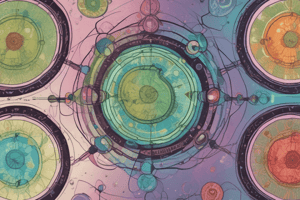Podcast
Questions and Answers
What is DNA replication?
What is DNA replication?
The process by which DNA is copied during the cell cycle
Where does DNA replication take place in the cell?
Where does DNA replication take place in the cell?
The nucleus
In what stage is DNA replicated?
In what stage is DNA replicated?
S Phase
What is the point of DNA replication?
What is the point of DNA replication?
What is a template?
What is a template?
Suppose that one strand of DNA has the sequence: TAGGTAC. What is the sequence of the complementary DNA strand?
Suppose that one strand of DNA has the sequence: TAGGTAC. What is the sequence of the complementary DNA strand?
What roles do proteins play in DNA replication?
What roles do proteins play in DNA replication?
What is DNA polymerase?
What is DNA polymerase?
Why is DNA replication called semi-conservative?
Why is DNA replication called semi-conservative?
What must happen in order for DNA strands to separate?
What must happen in order for DNA strands to separate?
What are the steps of DNA replication?
What are the steps of DNA replication?
Flashcards are hidden until you start studying
Study Notes
DNA Replication Overview
- DNA replication is the process that copies DNA during the cell cycle.
- It occurs in the nucleus of eukaryotic cells.
Key Stages and Processes
- DNA replication takes place specifically during the S Phase of the cell cycle.
- The purpose of replication is to ensure that each daughter cell receives a complete set of DNA after cell division.
- A template serves as a pattern for synthesizing complementary DNA strands.
Complementary Strands
- Given the DNA sequence TAGGTAC, the complementary strand also reads TAGGTAC, reflecting base pairing.
Role of Proteins
- Proteins are crucial in DNA replication; they facilitate the unzipping of DNA strands, hold them apart, and bond nucleotides to form new strands.
Important Enzymes
- DNA polymerase is the key enzyme responsible for forming bonds between nucleotides during replication.
Semi-Conservative Nature
- DNA replication is termed semi-conservative because each newly formed DNA molecule consists of one original (old) strand and one newly synthesized strand.
Mechanism of Strand Separation
- For the two strands of DNA to separate, the hydrogen bonds that connect base pairs must be broken.
Steps of DNA Replication
- Enzymes initiate the process by unzipping the DNA helix.
- DNA polymerase then binds nucleotides, creating new strands that are complementary to the original.
- This results in the formation of two identical DNA molecules ready for distribution to daughter cells.
Studying That Suits You
Use AI to generate personalized quizzes and flashcards to suit your learning preferences.




